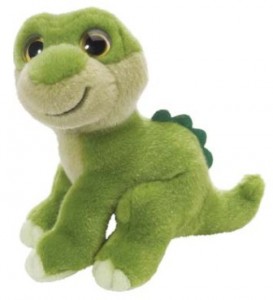The Joys of Working with Baby Dinosaurs – the wonders of Ontogeny
Ask any young dinosaur fan to draw a Diplodocus, an Apatosaurus and even a Brachiosaurus and they will most likely produce a picture of a big animal with a large body, a long tail and of course a very long neck, just the way these animals are depicted in books, CDs and television programmes. These dinosaurs, known as sauropods, are also commonly called long-necked dinosaurs as one of their distinguishing features is of course their elongated, muscular necks.
Baby Diplodocus
However, when it comes to working on a soft toy that depicts a baby Diplodocus, our thoughts about the typical long-necked dinosaur shape have to be discarded. Baby dinosaur fossils are extremely rare, baby sauropods are no exception. Unfortunately, a baby Diplodocus would have made a nice bite-sized snack for a hungry Allosaurus so if a youngster happened to perish in a location where fossilisation had a chance of occurring, chances are the body would have been eaten before sediments could cover the remains up.
Very occasionally a baby or a juvenile fossil sauropod is found. One nearly complete specimen was discovered at the Howe Quarry, near the town of Shell in Wyoming, USA. When fully excavated this little long-neck measured just over 2.4 metres long. Although, the skeleton was just about complete, the head was missing (a problem palaeontologists usually face with all sauropod remains); so it has proved difficult to assign this animal to any genus of sauropod, but the consensus of opinion is that this little chap (or young lady) was an Apatosaurus. The fossil shows a relatively, short neck compared to the adults. This fossil was extracted from sediments which make up the famous Morrison formation, it has been dated to the late Jurassic, approximately 145 million years ago. The original fossils are on display in a museum in Switzerland.
But how do we know that this animal was a youngster? Could it be a new species of mini-sauropod? The fossils have provided us with a number of clues to indicate that this animal was a juvenile, only a few years old. Firstly, as we get older some of our bones grow closer together and fuse, the same applies to dinosaurs. The fossil shows unfused bones in the hip region, tail and the scapula (shoulder blade). The lack of wear and tear on the wrist and ankle bones also supports the theory that this animal was quite young when it died. Dinosaur bones, if thinly sliced and studied under a powerful microscope can show growth rings, similar to the growth rings seen in wood. The tiny femur (thigh bone) was analysed and its study revealed that the animal was less than 5 years old.
The Baby Diplodocus Soft Toy (with a short-neck)
Picture credit: Everything Dinosaur
Dinosaur Stuffed Animals: Dinosaur Soft Toys.
So when it comes to thinking about a baby Diplodocus soft toy we have to consider the process of ontogeny. As animals grow their body proportions change, its physical features change in relation to body size. A foal looks very different from its mother. Its head looks larger, and the legs are proportionately longer. This trait is related to a process called distal growth. Another beautifully preserved and virtually complete skeleton of a baby long-necked dinosaur was discovered in Utah in 1922. This time the head was preserved and the fossil was identified as a Camarasaurus, it had a large head and a relatively short neck when compared to an adult. This was the basic blueprint for our baby Diplodocus in both the Itsy Bitsy and the Pocket Pals range of soft toys.
Eggs the Size of Footballs
Scientists think that animals like Diplodocus laid eggs about the size of footballs, buried in clutches of about 100 eggs or so. After incubation the eggs hatched and the young sauropodlets emerged on mass just as turtles and crocodiles do. This would give some of the babies the opportunity to get away from predators. Palaeontologists estimate that at hatching a baby Diplodocus was around 1 metre in length. Hiding in the fern undergrowth of forests the youngsters probably spent their first few years away from the adults living in small groups, using the dense forest as cover to protect them from the many predators that were about. Their growth rates were astonishing, it has been estimated that in their first year these animals with their constant feeding on mosses and ferns, were able to put on about 2 kilogrammes per day and that after 12 months these young dinosaurs were over 3 metres in length and weighed as much as an adult Friesian cow.
The Pocket Pals Diplodocus
Picture credit: Everything Dinosaur
As Everything Dinosaur is a company made up of parents, teachers and real dinosaur experts we have tried to illustrate scientific principles behind the products that we put into our shop. As with the Itsy Bitsy soft toy Diplodocus, in the slightly larger (and older) Pocket Pal Diplodocus we have tried to keep the head relatively large with the neck and tail short. Naturally, this process can only go so far, because with the adults the heads were very small compared to the body proportions. For example, a fully grown Diplodocus could exceed 30 metres in length, the head being about the size of a horse’s balanced on a neck that was as long as a bus.
Dinosaur Stuffed Animals: Dinosaur and Prehistoric Animal Soft Toys.








Leave A Comment